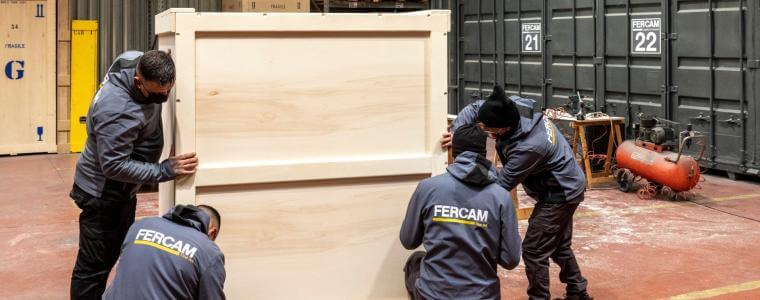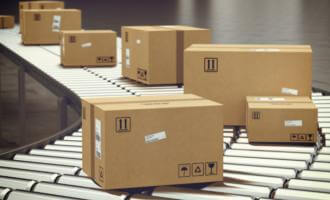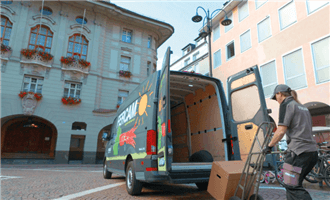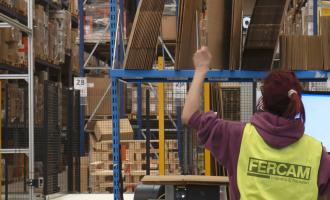
How to transport a work of art?
What is hidden behind a museum setup, an art gallery exhibition? Among the actors who make it possible for the viewer to experience that moment of enchantment in front of an artwork, there is also a team of logistics operators specialized in the Fine Art sector, who know how to transport these unique goods with the utmost care.

«The logistic operator who handles art contributes to the protection and enhancement of a unique product. The specificity and value of the art object to be transported imply the need for highly specialized logistics, which includes attention to safety in the smallest details and the care of a complex logistics project. A project that each time is unique, just as the artworks themselves are unique; and even if it were a question of moving the same piece several times, the place and time of destination, the methods of preparation and use, and other related activities would be different (in addition to transport, storage, packaging, risk evaluation, insurance, ministerial and/or customs procedures, etc.). The peculiarity of the art logistics operators' services, therefore, is expressed in their high specialization: knowledge and competence aimed at the protection of every cultural asset and, at the same time, at its enhancement in the public's experience of use», comments Alessandra Cozzolino, Associate Professor of Economics and Business Management in the Management Department of the Faculty of Economics at the Sapienza University of Rome, where she teaches and conducts research in the field of supply chain management, and is currently working on the study of art logistics management.
Art logistics primarily means risk management
What the logistics operator has to handle in the Fine Art sector is often an extremely fragile and precious cargo, whose value goes far beyond what is expressed in economic terms. The primary objective of those who provide this type of service is to protect the artwork during operations, limiting as much as possible the risks inherent in the activities of collection, movement, and installation.
For this reason, every asset requires a specific intervention that must be carefully planned, with an operational plan that is studied in detail. At the same time, experience and competence are crucial to be able to face unexpected events, so that changes and sudden needs can be immediately managed in the most suitable way.
«It is», explains Prof. Cozzolino, «a special and personalized logistics, with tailor-made solutions created ad hoc as part of a detailed design, which can include interesting margins of innovation. Innovation is required for the resolution of specific managerial and organizational needs, which may arise at the design stage, during construction, or in response to emergencies. These innovations may concern tools, techniques or processes, even in the technological and digital fields».
Relying on state-of-the-art equipment is, therefore, an indispensable element to limit fading, stains, fingerprints as well as possible impacts, falls, and bumps that can cause breakage, wear or compromise the integrity of the work of art. Attentionshould also be paid to temperature, air humidity, light intensity, and avoiding contact with any chemical products that could alter the state of conservation.
That hidden detail: packaging and its temperatures
To adequately manage any possible risk, the Fine Art transporter designs and manufactures customized, high-quality packaging, that is, in compliance with the unique technical characteristics of each work, their weight and volume, and the identified mode of transport (by road, air, or sea). These packagings are constructed with certified, fireproof, waterproofing materials and, if necessary, equipped with air conditioning systems to ensure transport in total safety.
«In the latter case, the artwork crate is generally provided at least one day in advance of the date and time scheduled for operations», explains Chiara Prisco, FERCAM Fine Art BU Manager. «This is also done at the end of the journey so that the work of art can experience a period of acclimatization upon delivery before opening the packaging and before its installation. In other words, the crate is allowed 24 hours to adapt to the conditions in which the piece normally lived before its departure and to release them gradually during transport».
To record these parameters, the art transporter generally installs a Datalogger inside the crate, in order to share a detailed examination of the temperature and humidity variations that the work may experience during its transit with the Customer or with the institutions involved. The Datalogger data are shared in real time with all parties involved so that the type of stress and condition experienced by the artwork during its journey can be accurately analyzed.
FERCAM Fine Art: special service with high added value
As a multi-specialized transport and logistics operator, FERCAM in its Special Services Division has a team of Fine Art expert professionals, dedicated to the management of all activities related to works of art handling. The mere transport phase, albeit very important, it is in fact only one of the services that are performed. FERCAM Fine Art is a partner in every process stage, from the first technical consultancy to the positioning and preparation of the work of art, dealing with:
• Confirm the size, value, and material of the asset
• Carry out any import/export customs procedures
• Carry out an on-site inspection (measurement of the works, verification of transport requirements)
• Design and produce ad hoc packaging by specialized technicians
• Organize the collection service
• Check the condition of the property after starting work
• Take care of the deposit phase (with warehouses equipped with safety systems, also in terms of temperature and air conditioning)
• Transport the work with specifically equipped vehicles
• Deliver the goods, verifying their conditions and hadling installation
• Manage storage and other ancillary services if necessary, based on the customer's needs
Chiara Prisco comments: «every day we become more convinced of the intrinsic wonder of our job. Each project is different from the other, each Work asks to be studied, known, and respected. It is difficult to generate a 'rule' and speak of a general order of things in our area. Each situation has its own specificity to be analyzed with minutia and attention».
Find out more about our Fine Art solutions!


 Language
Language

























